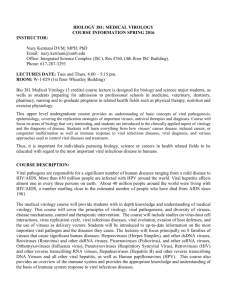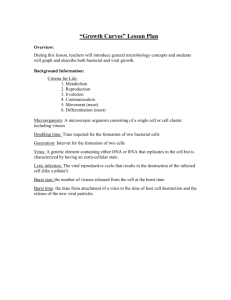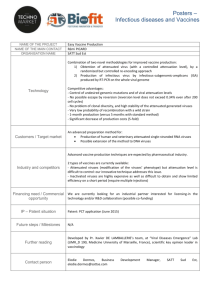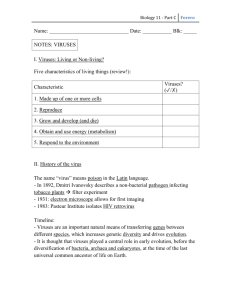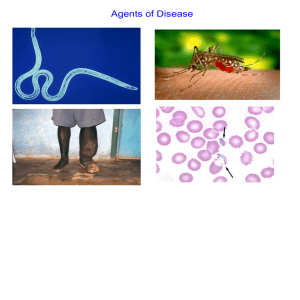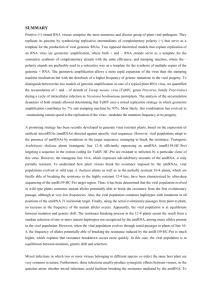Date - University of Massachusetts Boston
advertisement
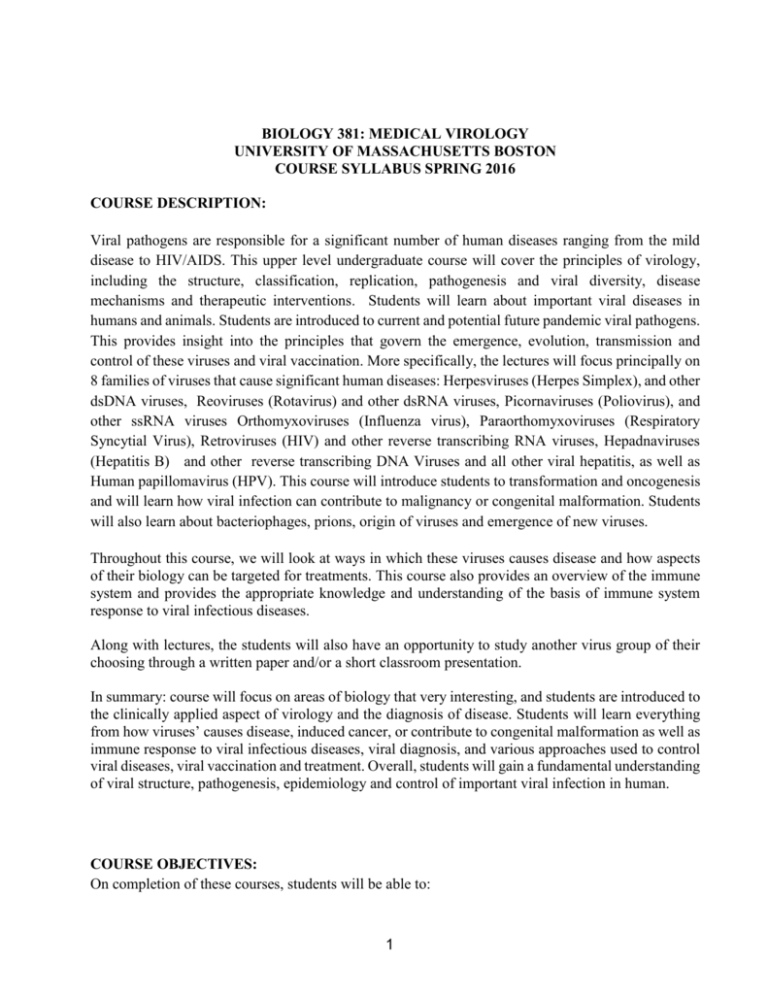
BIOLOGY 381: MEDICAL VIROLOGY UNIVERSITY OF MASSACHUSETTS BOSTON COURSE SYLLABUS SPRING 2016 COURSE DESCRIPTION: Viral pathogens are responsible for a significant number of human diseases ranging from the mild disease to HIV/AIDS. This upper level undergraduate course will cover the principles of virology, including the structure, classification, replication, pathogenesis and viral diversity, disease mechanisms and therapeutic interventions. Students will learn about important viral diseases in humans and animals. Students are introduced to current and potential future pandemic viral pathogens. This provides insight into the principles that govern the emergence, evolution, transmission and control of these viruses and viral vaccination. More specifically, the lectures will focus principally on 8 families of viruses that cause significant human diseases: Herpesviruses (Herpes Simplex), and other dsDNA viruses, Reoviruses (Rotavirus) and other dsRNA viruses, Picornaviruses (Poliovirus), and other ssRNA viruses Orthomyxoviruses (Influenza virus), Paraorthomyxoviruses (Respiratory Syncytial Virus), Retroviruses (HIV) and other reverse transcribing RNA viruses, Hepadnaviruses (Hepatitis B) and other reverse transcribing DNA Viruses and all other viral hepatitis, as well as Human papillomavirus (HPV). This course will introduce students to transformation and oncogenesis and will learn how viral infection can contribute to malignancy or congenital malformation. Students will also learn about bacteriophages, prions, origin of viruses and emergence of new viruses. Throughout this course, we will look at ways in which these viruses causes disease and how aspects of their biology can be targeted for treatments. This course also provides an overview of the immune system and provides the appropriate knowledge and understanding of the basis of immune system response to viral infectious diseases. Along with lectures, the students will also have an opportunity to study another virus group of their choosing through a written paper and/or a short classroom presentation. In summary: course will focus on areas of biology that very interesting, and students are introduced to the clinically applied aspect of virology and the diagnosis of disease. Students will learn everything from how viruses’ causes disease, induced cancer, or contribute to congenital malformation as well as immune response to viral infectious diseases, viral diagnosis, and various approaches used to control viral diseases, viral vaccination and treatment. Overall, students will gain a fundamental understanding of viral structure, pathogenesis, epidemiology and control of important viral infection in human. COURSE OBJECTIVES: On completion of these courses, students will be able to: 1 1. Explain the principles of virology, including the structure, replication, classification and diversity of viruses. 2. Describe the viral virulence mechanisms, control, viral vaccination and therapeutic intervention. 3. Describe the pathogenesis of selected viruses (eg. herpesviruses, rotaviruses, Flu viruses, paramyxoviruses, polioviruses, HIV, HPV, and viral hepatitis) hat cause significant human diseases across lifespan. 4. Describe how viral infection can contribute to malignancy or congenital malformation. 5. Describe how interactions among environmental context, heredity, age, and race/ethnicity affect the incidence and prevalence of selected viral infection diseases. 6. Describe how interactions between the host immune response and viral infection. 7. Synthesize and apply current research based knowledge about the pathophysiologic processes underlying important selected viral infection. INSTRUCTOR: Nazy Kermani DVM; MPH; PhD Email: nazy.kermani@umb.edu Office: Integrated Science Complex (ISC), Rm 4760, (4th floor ISC Building). Phone: 617-287-3293 Office Hours: Tuesdays and Thursdays 12-1:00 pm, or by appointment. Please feel welcome to talk with the instructor about any aspect of the course or your university education in general. Please note that just before lecture is usually a busy time. IMPORTANT NOTE: You are responsible for understanding all of the course rules and regulations that are described in this syllabus. Please read the syllabus carefully. LECTURES: Lectures times: Tues and Thurs, 4:00 – 5:15 pm. Room: W-1-029 (1st floor Wheatley Building). PREREQUISITES: Bio 381 Medical Virology (3 credits) lecture course is designed for biology and sciences majors students, as well as nursing and other health related fields students. The course will provide an understanding of the scientific basis of established and novel medical virology concepts that are required for students preparing for admission to professional schools in medicine, veterinary, dentistry, 2 pharmacy, and nursing and to graduate programs in health related fields. The following prerequisites for Biology 381 must be met: Biol 210 or Biol 212 Cell Biology or permission from Dr. Kermani. This course will require a good understanding of cell biology (transcription, translation and DNA replication). If you signed up for the course but have not met all of the prerequisites, you must see Dr. Kermani. You may be dropped from the course at a later date. REQUIRED MATERIALS: Textbook Virology: Principles and Applications: by John Carter, Venetia Saunders, 2nd Edition, 2013. John Wiley, Publisher. Some library research and PubMed searches to be done by students will also be required. Reserve Room - Healey Library: A copies of the above Virology Textbook and the Reference book of Virology: 2 Volumes by S.J. Flint, 3rd Edition, 2013, are on reserve at Healey Library. PowerPoint lectures will be posted on Blackboard. TEACHING METHODS: Lectures 3 hours/week: Lectures will present information on concepts that will be needed for future lectures; therefore, regular class attendance is important. Lectures will emphasize and expand on specific aspects of the book chapter and/or scientific journals. Students are expected to bring questions and have in-depth discussions of class content. Important note: Students should study lectures material that covered in the class, exams will be based on class lectures (≈95%). ATTENDANCE: Students are expected to attend all lectures. Participation accounts for 5% extra credit of your final grade. Your lecture participation grade will be determined by your response to iClicker questions. Questions will be asked during each class. Your response (regardless of accuracy) will be used for your grade. In addition, if your answer is correct you also get extra points. Two absences will be excused. This allows for any unavoidable absences or possible problems with your iClicker; no additional consideration will be taken. It is your responsibility to come to class with the iClicker. If you must miss a lecture, it is your responsibility to find out what you missed, including any announcements. READING ASSIGNMENTS: It is important that you read and study all of the assigned material. EXAMS: 3 exams of multiple choice, true/false, and short essay questions. There will be 2 class exams 3 plus a final exam. The final exam will be given during the final exam period, it is comprehensive, and that is, it covers material from the entire course. However, there will be a more emphasis on material covered since the second exam. CONFLICTS: All students must take exams at the scheduled times. This policy is strictly enforced. It is your responsibility to take exams at the scheduled times. If the examination time conflicts in an emergency situation, please contact Dr. Kermani to arrange an alternate time. Usually, no make-up exams will be given without a documented medical excuse. GRADING: Exam 1 25% Exam 2 25% Final Exam 40% Scholarly Paper 10% Your participation and correct answer to I clicker questions accounts for 5% extra credit of your final grade. Also additional 5% extra credit can be obtained by giving a short classroom presentation. SCHOLARLY PAPER: Students will have the opportunity to write a 5-10 page paper on primary literature on a virus not covered in the lecture. The paper will include: 1. Description of the exemplar (viral structure, classification, epidemiology). 2. Description of the pathologic process. 3. Control and therapeutic intervention of viral pathogen. 4. Current inconsistencies and debates in theoretical and empirical literature, if any 5. References. Scholarly paper is required for the course and accounts for 10% of your final grade. It is due on Thursday April 28th. You should upload on Blackboard (Paper assignment) before or on April 28th (11:59pm eastern time). Note: Past due paper will not be graded. PRESENTATIONS (OPTIONAL): Students will also have the opportunity to make a short classroom presentation for 5% extra credit. INCOMPLETES: The grade of incomplete is given only when a specific component of the course cannot be completed due to illness or other extenuating circumstances. To request an incomplete, you must be passing the course. These are University regulations. BLACKBOARD LEARNS: Blackboard learns will be used for distributing course materials (lecture slides, handouts, etc.) and announcements. Students are encouraged to use the site regularly. Students can download lecture 4 materials and handouts before each lecture. Lecture materials will be posted on the Blackboard every week for downloading. CELL PHONES: Use of cell phones and other electronic devices in class is strictly prohibited. They must be POWERED OFF. TIPS FOR DOING WELL IN THE COURSE: Go to every lecture. Pay close attention and take notes, making special note of concepts that are confusing and questions you have about the material. Read the lecture and also textbook in advance of lecture but then review it again soon after lecture in light of your lecture notes and lecture printouts. Know lecture material and your textbook: While studying, pay attention to the big picture—the underlying concepts that tie the material together. ACCOMMODATIONS FOR STUDENTS WITH DISABILITIES: The University of Massachusetts Boston is committed to providing appropriate academic accommodations for all students with disabilities. If you have a disability and feel you will need accommodations in this course, please contact: The Ross Center for Disability Services Campus Center, Upper Level, Room 211 (617-287 7430). http://www.umb.edu/academics/vpass/disability After registering with the Ross Center, a student should present and discuss the accommodations with the professor. Although a student can request accommodations at any time, we recommend that students inform the professor of the need for accommodations by the end of the Add/Drop period to ensure that accommodations are available for the entirety of the course. CODE OF CONDUCT AND ACADEMIC INTEGRITY: It is the expressed policy of the University that every aspect of academic life--not only formal coursework situations, but all relationships and interactions connected to the educational process-shall be conducted in an absolutely and uncompromisingly honest manner. The University requires that any work submitted for academic credit is the student’s own and complies with University policies, including policies on appropriate citation and plagiarism. These policies are spelled out in the Code of Student Conduct, which can be found at this website: The Code is available online at: http://www.umb.edu/student services/student rights/code conduct.html. Students are required to adhere to the Code of Student Conduct, including requirements for academic honesty. Penalties for academic misconduct in the course, including plagiarism and cheating, are strictly enforced, and the penalties are very serious. Penalties include an F in the assignment or exam, an F in the course, or suspension from the University. If you have questions about what constitutes plagiarism or other forms of academic misconduct, see Dr. Kermani or the Teaching Assistant before completing an assignment or exam. 5 Ignorance of the rules does not excuse any academic conduct violation. The University defines violations to include, but not be limited to the following: Submitting as one’s own an author’s published or unpublished work (e.g. material from a journal, Internet site, newspaper, encyclopedia), in whole, in part, or in paraphrase, without fully and properly crediting the author. Submitting as one’s own work or materials obtained from another student, individual, or agency without full and proper attribution. Submitting as one’s own work material that has been produced through unacknowledged or unauthorized collaboration with others. Submitting substantially the same work to more than one course (i.e., dual or multiple submissions) without prior approval from all instructors involved. Using any unauthorized material during an examination, such as notes, tests, calculators, cell phones, or other electronic devices. Obtaining answers to examination questions from another person with or without that person’s knowledge; furnishing answers to examination questions to another student; using or distributing unauthorized copies of or notes from an examination. Submitting as one’s own an examination taken by another person; or taking an examination in another person’s place. Interfering with an instructor’s ability to evaluate accurately a student’s competence or performance; misleading any person in connection with one’s academic work. QUESTIONS OR PROBLEMS? Or, just want to discuss the course, see Dr. Kermani. I am here to help you succeed. 6 BIOLOGY 381- MEDICAL VIROLOGY-SPRING 2016 Syllabus: Lecture Schedule Week Date 1 Jan. 26 (Tu) 3 Chapter 1 Feb. 2 (Tu) Viral Diagnosis Feb. 4 (Th) Viral Replication and Life cycle Viral attachment Transcription, Translation, and Transport Viral genome replication Viral assembly and exit Patterns of virus infections (principles of pathogenesis) Chapter 2 (Material covered in the Lectures) Partial Chapters 5, 6, 7 and 8 Material covered in the lectures Feb. 9 (Tu) Viral Classification Herpesviruses and other dsDNA Viruses Herpes simplex virus 1 and 2 Varicella-Zoster virus Epstein-Barr virus Human cytomegalovirus Haman herpesvirus 6 and 7 Haman herpesvirus 8 (Kapopsi’s sarcoma) Chapters 10 and 11 Material covered in the lectures Picornaviruses and other ssRNA viruses Poliovirus Rhinovirus, Foot-and-Mouth disease virus Coxsackieviruses Hepatitis A virus Chapter 14 Material covered in the lectures Feb. 11 (Th) 4 Readings Introduction to Virology What are viruses? Medical importance of viruses History and properties of viruses Human microbiome Virus Structure Virus transmission Jan. 28 (Th) 2 Topic Feb. 16 (Tu) Fib. 18 (Th) 7 Chapters 3 and 4 Only material covered in the lectures) 5 6 Feb. 23 (Tu) Reoviruses and other dsRNA Viruses Rotavirus Feb. 25 (Th) EXAM 1 (75 minutes) March 1 (Tu) Orthomyxoviruses and other ssRNA viruses March 3 (Th) 7 March 8 (Tu) 11 12 Influenza Virus Chapter 22 Material covered in the lectures Retroviruses and other Reverse transcribing RNA Viruses HIV/AIDS (unique, major worldwide impact) Pediatric AIDS (PAIDS) Chapters 17 and 18 Material covered in the lectures March 31 (Th) Hapadnaviruses and other Reverse Transcribing DNA Viruses Hepatitis B Virus Other viral hepatitis (Hepatitis A, C, D, E and E) Chapter 19 Material covered in the lectures Partial Chapter 14 April 5 (Tu) April 7 (Th) EXAM 2 (75 minutes) Chapter 23 Material covered in the lectures April 12 (Tu) Transformation and Oncogenesis Viruses and Cancer HPV-Linked cancer (HPV) Polyomavirus-Linked cancer Epstein-Barr- Linked cancer Kaposi’s Sarcoma Adult T Cell Leukemia HBV and HC- linked hepatocellular carcinoma March 22 (Tu) March 24 (Th) 10 Chapter 16 Material covered in the lectures Paramyxoviruses Parainfluenza Virus Measles Mumps Respiratory syncytial virus March 10 (Th) 9 Chapter 13 Material covered in the lectures March 29 (Tu) April 14 (Th) Human Papillomavirus (HPV) 8 Chapter 23 Material covered in the lectures 13 14 15 16 April 19 (Tu) Viruses and Cancer continued April 21 (Th) Bacterial Viruses (Bacteriophage) April 26 (Tu) Origins and evolution of Viruses April 28 (Th) Emerging Viruses Virus Vaccines May 3 (Tu) Anti-viral Drugs May 5 (Th) Anti-viral Drugs continued Prion May 10 (Tu) Host defenses against viral infections Chapter 23 Material covered in the lectures Chapter 20 Material covered in the lectures Chapter 21 Material covered in the lectures Chapters 22 and 25 Material covered in the lectures Chapter 26 Material covered in the lectures Chapter 27 Material covered in the lectures May 12 (Th) 16 May 16-20 FINAL EXAM WEEK (Room W-1-034) Note: Important dates: Monday, February 1: Add/Drop Period Ends Wednesday, April 20: Pass/Fail and Course Withdrawal Deadline. Note: The Final Exam will be given during Final Exam Period, May 16-20. You must be available during exam dates. The exact date and time are set by the Registrar’s Office and will be announced. The Final Exam is comprehensive; that is, it covers the entire semester. However, there will be a more emphasis on material covered since the second exam. 9
